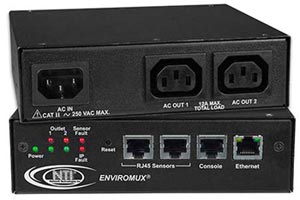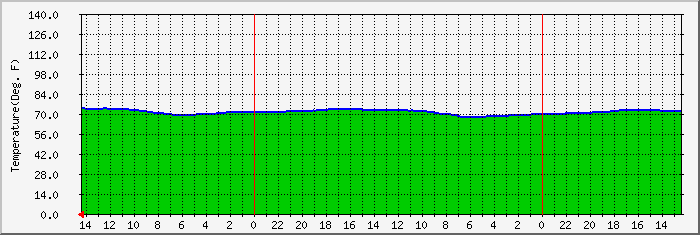Graph Critical Environmental Conditions
The IPDU-S2 Secure Remote Power Reboot Switch graphs data from its sensors using MRTG.
ENVIROMUX® Secure Remote Power Reboot Switch Graph Critical Environment Conditions with MRTG

IPDU-S2 (Front and Back)
Monitoring environmental conditions around servers, work stations or data centers helps prevent the damages caused to valuable equipment by environmental conditions like temperature, humidity, water leakage etc.
The Network Technologies Inc IPDU-S2 Secure Remote Power Reboot Switch monitors environmental conditions and notifies the administrator or staff via email, SNMP traps, web-page alerts etc. if a sensor goes out of range of a pre-configured limit.
Graphing using MRTG (Multi Router Traffic Grapher) provides a visual representation of the critical environmental conditions being monitored. MRTG generates HTML pages containing regularly updated PNG images providing graphical trending of time-series data. The graphs display daily, weekly, monthly and yearly statistics of the environmental conditions being monitored.
The Network Technologies Inc IPDU-S2 Secure Remote Power Reboot Switch monitors environmental conditions and notifies the administrator or staff via email, SNMP traps, web-page alerts etc. if a sensor goes out of range of a pre-configured limit.
Graphing using MRTG (Multi Router Traffic Grapher) provides a visual representation of the critical environmental conditions being monitored. MRTG generates HTML pages containing regularly updated PNG images providing graphical trending of time-series data. The graphs display daily, weekly, monthly and yearly statistics of the environmental conditions being monitored.
Sample Graphs
Internal Temperature: Daily Graph (5 Minute Average)
| Max | Average | Current | ||
| 73.7 °F | 71.1 °F | 73.7 °F |
Office Temperature: Weekly Graph (30 Minute Average)

| Max | Average | Current | ||
| 73.5 °F | 71.6 °F | 73.4 °F |
Configuration
Configure MRTG to graph environmental conditions using the IPDU-S2 Secure Remote Power Reboot Switch:1) Install MRTG on your computer using the MRTG installation guide.
- Installation procedure is available at:
2) Configure the IPDU-S2 Secure Remote Power Reboot Switch to monitor the environmental conditions you want.
3) Create a MRTG configuration file that controls the graphs.
- Download the IPDU-S2 configmaker for MRTG
- How to use the IPDU-S2 Secure Remote Power Reboot Switch configmaker for MRTG
- Sample mrtg.cfg file created using the ipdus2-cfgmaker script
- Note: Note: You can also edit the summary HTML file below to display data from the sensors you use:
5) Create a cron job to run MRTG on UNIX machines. Use a daemon on Windows.
6) Modify MRTG graphs.
- The default graphs generated by the MRTG configuration script can be modified. Following are examples of changes to the graphs that can be made.
